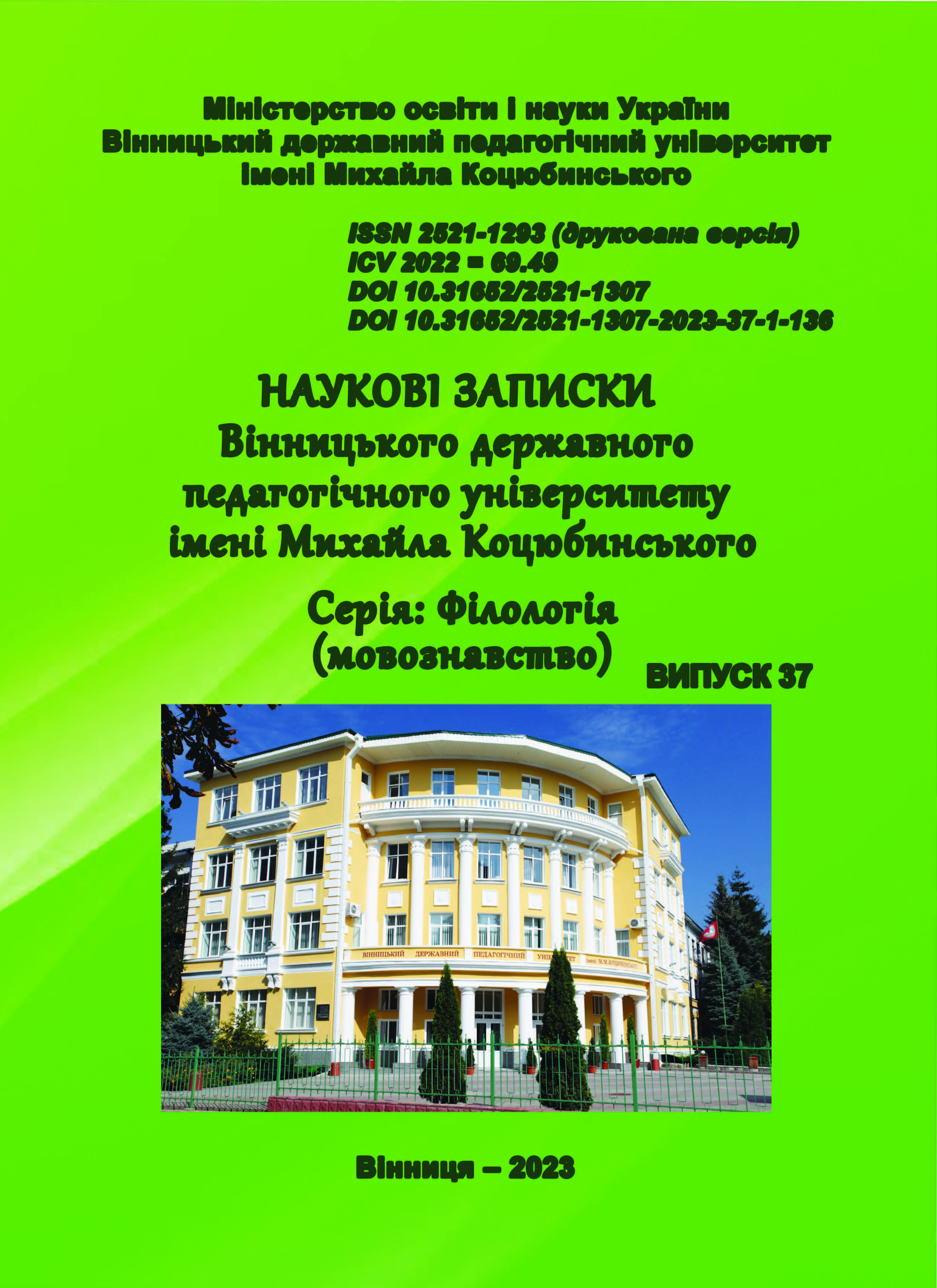Communicative and pragmatic ability of the simple subject in modern ukrainian prose for children
https://doi.org/10.31652/2521-1307-2023-37-46-57Published 2023-12-20
Keywords
- main clause, simple subject, simple two-syllabic sentence, communicative-pragmatic ability, emotional-expressive coloring, language of modern Ukrainian prose for children
Copyright (c) 2023 Руслана Горобець

This work is licensed under a Creative Commons Attribution 4.0 International License.
How to Cite
Abstract
Introduction. The article examines various approaches to the interpretation of the subject as the main member of a simple two-syllabic sentence, highlights its formal-semantic and morphological-syntactic qualification features. The forms of expression of the simple subject in the language of modern Ukrainian prose for children are analyzed and the specifics of its functioning in "children's" contexts are outlined. The communicative-pragmatic capacity of various types of the subject determined by the intentions of the authors, the purpose of the analyzed works, the age and psychological characteristics of the addressee, and other extralinguistic factors have been clarified. Objectives. The purpose of the article is to determine the structural-semantic and communicative-pragmatic features of the subject in the language of modern prose works for children: to outline the structural-semantic specificity of the functioning of the subject in the language of works for children; to clarify the communicative and pragmatic potential of sentences with an expressively colored subject in their structure; to determine the factors affecting the choice of the subject in the contexts of children's perception of textual information.
Methods. The method of linguistic and contextual analysis.
Results. It was determined that the communicative and pragmatic capacity of the simple subject in the language of works for children is realized in different ways. The most active are subjects expressed by nouns. First of all, it is related to proper names, which are an effective means of activating the child's attention, contribute to the development of his/her thinking, imagination, fantasy, and also expand information about the heroes, serve as their micro-characteristics. The analysis of the functioning of the subject in the language of works for children can serve as a basis for characterizing the idiostyle of a modern Ukrainian children's writer, his/her language skills.
Originality. In linguistics, a subject that has not been fully studied up to now deserves special attention. First of all, it concerns the peculiarities of functioning in works of art, their role in revealing the ideological intention of the author, and stylistic properties. In linguistics, there is still no special research on the peculiarities of the communicative and pragmatic ability of the simple subject in the language of modern prose works for children, which determines the relevance of our article.
Conclusion. The subject in works for children vividly reveals communicative and pragmatic ability. Especially interesting are the subjects presented with casual names, which create a powerful comic effect, thanks to which small recipients form stable ideas about the general categories of good and evil. Thanks to the use of an proper name, the communicative situation does not require additional characteristics of the hero. It is in the creation of such a context that the skill of the writer will be revealed, their ability to concentrate, to reproduce reality, to reveal fantasy, to bring the story closer to the reader with efficient language means.
Downloads
References
- Бацевич Ф. Лінгвістична генеологія: проблеми і перспективи. Львів: ПАІС, 2005. 254 с.
- Вихованець І. Р. Граматика української мови. Синтаксис: підручник Київ: Либідь. 1993.
- Грищенко А. П. Проблема підмета. Українське мовознавство: міжвід. наук. збірник Київського нац. ун-ту ім. Т. Шевченка, 2004. Вип. 30. С. 43–48.
- Дудик П. С. Із синтаксису простого речення. Вінниця : Вінницький держ. пед. ун-т ім. Михайла Коцюбинського, 1999. 287 с.
- Завальнюк І. Я. Синтаксичні одиниці в мові української преси початку ХХІ століття: функціональний і рагмалінгвістичний аспекти: монографія. Вінниця: Нова Книга, 2009. 400 с.
- Іваницька Н. Л. Взаємна зумовленість форм головних членів двоскладного речення. Українська мова і література в школі. 1979. № 10. С. 27–34.
- Ковалів Ю. І. Літературознавча енциклопедія. Київ: Видавничий центр «Академія», 2007. Т. 1. 608 с.
- Козачук Г. О. Підмети, виражені словосполученням. Українська мова і література в школі. 1982. № 1. С. 36–39.
- Мельничук О. С. Розвиток структури слов’янського речення. Київ: Наукова думка, 1966. 314 с.
- Москаленко Н. А. Підмети, виражені словосполученням. Українська мова і література в школі. 1970. № 9. С. 23–32.
- Недбайло Л. І. Структура підмета. Синтаксис словосполучення і простого речення. Київ: Наукова думка, 1975. С. 46–59.
- Попович А. С. Стилістика української мови: навчально-методичний посібник. Кам’янець- Подільський: Кам’янець-Подільський національний університет імені Івана Огієнка, 2017. 172 с.
- Українська мова. Енциклопедія / Редкол.: В. М. Русанівський, О. О.Тараненко (співголови), М. П.Зяблюк та ін. Вид. 3-тє, зі змінами і доп. Київ: «Українська енциклопедія» імені М. П. Бажана. 2007. 856 с.
- Українська мова : словник-довідник / Загнітко А. П., Познанська В. Д., Омельченко З. Л., Мозгунов В. В. Донецьк : Центр підготовки абітурієнтів, 1998. 144 с.
- Шульжук К. Ф. Синтаксис української мови: підручник. Київ: ВЦ «Академія». 2004. 408 с.





